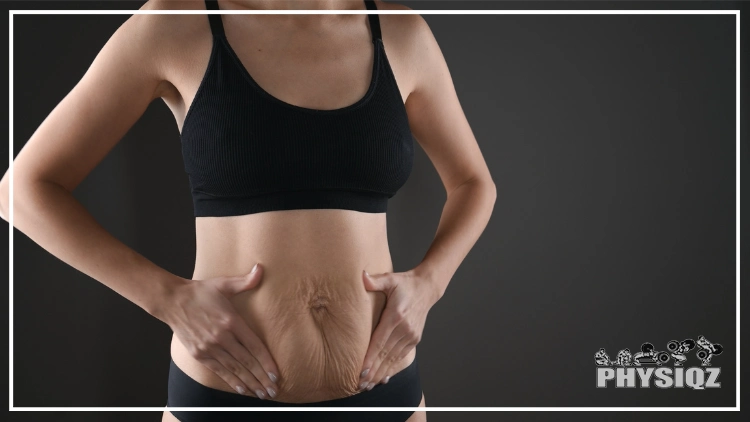
On the journey to become the healthiest version of yourself, flappy skin following weight loss surgery is quite common and while it may be aesthetically displeasing to some, it is a huge milestone you should be proud of — and luckily there are both surgical means to remove the excess skin, as well as ways to tighten it naturally.1
Procedures such as tummy tucks, lifts, panniculectomies and liposuction are generally the most effective ways to have no loose skin in cases of extreme weight loss.
But for those who only have a little excess skin or are weary of additional surgeries may want to opt for natural or non-invasive approaches.
This guide provides an in depth review of ways to manage excess skin following weight loss surgery so you can feel more comfortable in your own skin and decide which is the best approach based on your circumstances, preferences, and willingness to go undergo surgery.
How To Tighten Excess Skin Without Surgery
After considerable weight loss, it’s common to have a lot of excess skin because as the body gets smaller, the skin often cannot tighten at the same rate.
This can leave sagging skin after massive weight loss, especially because collagen–which makes up 80% of skin structure and provides strength, firmness, and elasticity–is significantly thinner after being stretched with the initial weight gain.
This causes skin weakness, decreased thickness and density of collagen fibers, and vastly diminished elasticity so the skin cannot tighten beyond a certain point without intervention–whether surgical or not.2
Though skin tightening surgery is needed in some cases, the following methods explain how to tighten excess skin without surgery; these can be tried individually or simultaneously for better and faster results.
Firming Creams, Serums & Skin Care
There are countless skin tightening and firming creams, serums and skin care products now available to choose from; these are best for those who have a small amount of excess fat and often work by massaging them into the preferred area daily or even several times a day over a period of time.

Source: LittleBee80 via Canva.com3
The ingredients used promote increases in collagen and elastin to lessen dimples and sagginess throughout the stomach, thighs, neck, and other stubborn areas.
Proper Nutrients
Ensuring you’re eating a clean and nutritious diet is key to overall health and can promote youthful skin. Fruits contain skin-tightening nutrients, with pineapple being beneficial for weight loss, while citrus fruits like oranges are excellent for boosting elasticity.
Those wondering if oranges are good for weight loss are in luck, as oranges, lemons, and limes are beneficial for both weight loss and skin elasticity.
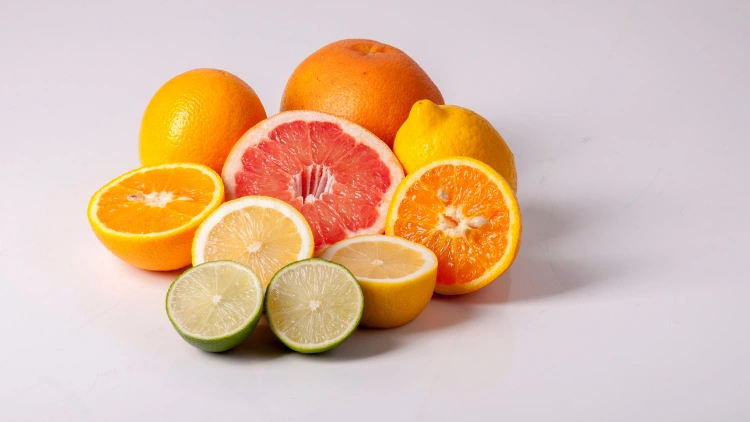
Source: eliv1 via Canva.com4
Additionally, avocado consumption increases skin elasticity and daily consumption can promote firmness.5 A few other skin tightening foods include:
- Broccoli
- Cabbage
- Low Fat Cottage Cheese
- Low Fat Yogurt
- Soy
- Sunflower Seeds
- Tofu
Body Recomposition & Building Muscle
One of the most effective ways to firm loose skin after weight loss surgery is through muscle toning or hypertrophy (building muscle size).
Increased muscle mass can be achieved through a starting strength routine and regular lifting, helping to fill out the body and reduce loose or saggy skin, resulting in a better appearance filled with lean muscle rather than fat or loose skin.
Stay Hydrated
Drinking water is a simple yet effective method of helping reduce saggy skin. Hydration allows the cells to look and be more healthy, youthful, and glowing and promotes total body health.
Vitamins & Supplements
Vitamins are not only greatly helpful in jump-starting weight loss but can also be just as effective in tightening flappy skin folllowing weight loss surgery.
Let’s discuss the vitamins that aid in weight loss: vitamin A hydrates the lower skin layer, vitamin C protects collagen and elastin, and vitamin E reduces sun damage to the skin. Collagen supplements are also available to boost not only skin health but hair and nail strength as well.
Home Remedies
Try several home remedies, including aloe vera, lemon, yogurt, and both green and hibiscus teas, to reduce weight in 7 days while also improving skin health and firmness, as these natural remedies are effective for both weight and loose skin reduction.
Dermarolling (Microneedling)
Another method of decreasing the amount of saggy or flappy skin following weight loss surgery is a treatment called “dermarolling” or “microneedling.”
This is the process of inserting thousands of very small needles into the top layer of skin with a rolling device, which makes very small wounds in the skin to promote greater production of elastin and collagen.
This treatment might not be for everyone, but is proven to reduce acne scarring, stretch marks, wrinkles, and loose skin and is often done every 4-6 weeks for best results.
Photos Before & After Non-Surgical Skin Tightening (With Methods Used)
The following are a couple of before and after photos of people who chose to use two of the non-surgical skin tightening methods listed above. We will explain which methods they chose and how often they did treatments.
Beth
Beth is passionate about maintaining her health, body, and skin as she ages and helps teach others over 50 how to do the same. As part of her skin care routine, Beth began doing dermarolling treatments monthly to help tighten and firm the skin in her abdominal region.
She noted that through microneedling, even her stretch marks faded drastically.
As you can see in her before and after skin photos below, the slight dimples and folds of skin really tightened to give her a more smooth and toned look.
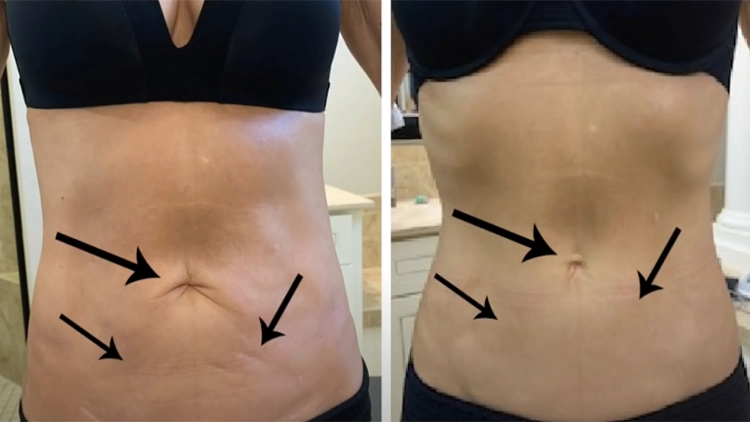
Beth’s monthly dermarolling treatments help her age gracefully and maintain youthful skin. Source: FiftyPlusBeauty on Youtube6
Lindy
After success with facial tightening using a serum called Bioeffect EGF, Lindy decided to try this on her loose skin across her abdomen that was left after pregnancy. Though she considered a tummy tuck, she wanted a more natural method and had incredible results with this serum.
As pictured below, Lindy was able to gain a much tighter and firmer look and get rid of the excess saggy skin below her belly button through daily application of Bioeffect EGF.
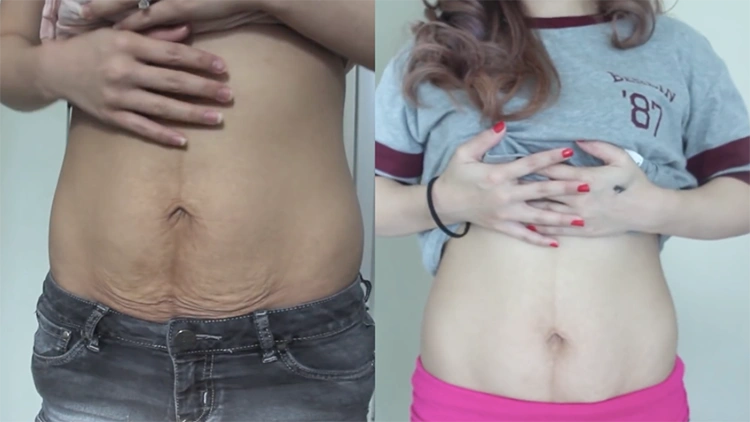
Lindy’s experience with skin tightening serum left her feeling more confident after pregnancy and really tightened the saggy skin across her abdomen. Source: bubzbeauty on Youtube7
Choosing Between Natural Methods & Skin Removal Surgery for Loose Skin After Weight Loss Surgery
Natural skin firming and tightening methods should be attempted before even considering surgery; even if skin tightening surgery ends up being necessary, by firming and toning beforehand, one can decrease the extensiveness of surgery while gaining healthier skin along the way.
Someone thinking about having a procedure done to reduce saggy skin after bariatric surgery like a gastric sleeve, gastric bypass, or biliopancreatic diversion should give all of the natural methods a thorough try instead of just dabbling in one or two methods or trying one firming cream and resigning themselves to surgery.
However, for those who have had massive weight loss or an excess amount of loose skin from weight loss surgery, a secondary surgery for tightening or removing excess skin may be the right option for you.
This can be especially true in aging patients with less skin elasticity, people with mobility issues, and in those with large amounts of excess skin from losing a considerable amount of their initial body weight.
Various Skin Removal Surgeries & Their Benefits After Weight Loss (Bariatric) Surgery
Those who notice flappy skin following weight loss surgery cannot always tighten it enough through natural means, yet may not feel comfortable with their loose skin either.
Sometimes excess skin can even get in the way of exercising and daily activities if the remaining skin folds are large or hang below one’s pantyline.
In fact, body contouring after massive weight loss can be very helpful in boosting one’s self-confidence, mental health, and emotional health because when natural methods don’t rid them of the excess skin folds, people can have body dysmorphia and endless reminders of their previously morbid obesity. Physical and mental health are closely tied, so removal of extra skin can increase self-confidence, pride, and overall well-being.8
A few non-surgical methods that can be done with a plastic surgeon, doctor, or other medical professional include cryolipolysis or “CoolSculpting” or lipolysis via laser, radiofrequency, or injections.
These methods either freeze or burn fat cells to locally reduce fat in various areas of the body.
Some non-invasive skin tightening treatment options such as the radiofrequency lipolysis–also called dermal heating–can immediately affect collagen structures in the skin to promote growth of new collagen and elastic fibers to start tightening and firming the skin instantly as these fibers shrink.
The thermal (heat) stimulation of the fibers increases the speed of fatty acid breakdown as well.9
In contrast to these effective non-surgical skin tightening methods–whether for functional, aesthetic, or self-confidence reasons–excess skin reduction may need to be done via surgery rather than less drastic procedures like those above. This is especially true for large amounts of excess saggy skin as non-surgical methods work best in small areas.
The following are several options for those who opt for the surgical route:
- Lifts: A “lift” is a surgical procedure to remove excess skin in various regions of the body, with results often lasting 5-10 years. This is a common procedure since it can be done in so many areas, including a thigh lift, upper arm lift, or face lift to give a smoother, sculpted, and tighter look and feel.
- Liposuction: Liposuction is the removal of fat via suction and can be done in many areas as well, such as abdomen, hips, thighs, chin, neck, upper arms, and buttocks. This decreases fat and puffiness in these regions and contours or shapes them.
- Panniculectomy: Done to remove stretched and saggy skin that hangs from the abdomen, a panniculectomy is a great option for those who have lost a significant amount of weight and want their body’s look to match their feeling and efforts.
- In some cases, excess skin may even hang below one’s thighs and genitals and can lead to discomfort, pain, and even infections within skin folds. Though usually successful, this surgery does have a high risk of complication.
- Tummy Tuck: Often called abdominoplasty is performed via several small incisions throughout the abdomen–or one large incision–and is similar to a panniculectomy but better for those who have a low to moderate amount of excess skin. Aside from tightening the skin, in an “extended tummy tuck” the abdominal muscles are also tightened, especially after pregnancy and massive weight loss.
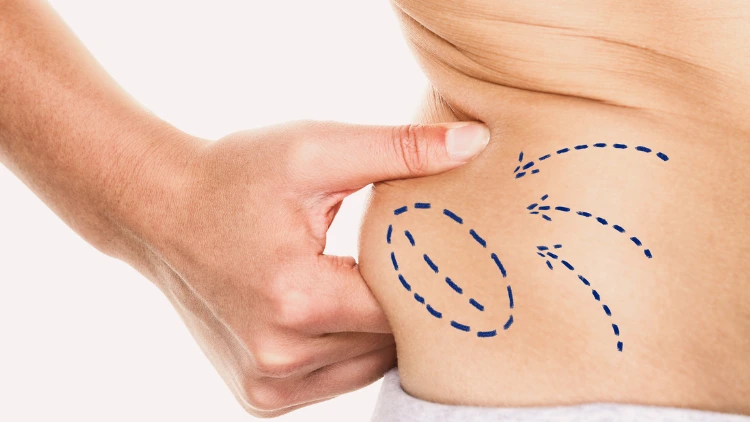
Source: Maridav via Canva.com10
Though having excess skin after losing a lot of weight via surgery or lifestyle changes is nothing to be ashamed of, it can interfere with body image, dysphoria, and even mobility.
Thankfully there are plenty of methods–both natural and surgical–to remove flappy skin following weight loss surgery so it’s just a matter of knowing which options are available and working with a healthcare professional to decide which is best for you.
Frequently Asked Questions
Is Flappy Skin After Slimming Down Surgery Normal?
Loose skin following weight loss is completely normal, since the skin inevitably stretches with initial weight gain and is left looser than before when the weight is lost. Thankfully there are plenty of options for naturally or surgically reducing this excess skin.
Which Is the Safest of Skin Reduction Surgeries?
The safest skin reduction surgery is liposuction as it’s minimally invasive, has a high success rate, and a quick recovery time.
How To Tell When Skin Removal Surgery Is Necessary?
Those who have lost weight but have either not loose skin or minimal loose skin don’t need excess skin reduction surgery, as tightening and firming can be achieved through natural methods like clean eating, exercise, topicals, vitamins, and body recomposition.
When skin removal surgery is necessary, it’s more for those who have lost great amounts of weight and for whom skin tightening methods can only do so much.
How Much Is Surgery To Remove Loose Skin After Weight Loss?
Skin removal surgery and their costs can vary greatly, with most “lifts” starting at the $4000 range and a panniculectomy sometimes hitting $15,000. Thankfully those who have insurance and had prior bariatric operation can often have their procedure fully or partially covered by insurance.
What Causes Excess Skin Post Weight Loss Surgery?
Some causes of excess skin after bariatric operation include aging, genetics, sun exposure, smoking, how much weight was lost, through which methods the weight was lost, as well as levels of melanin and collagen (which aid in elasticity).
References
1Изображения пользователя Татьяна Сергеенко. Canva. Accessed 25 April 2023. <https://www.canva.com/photos/MAEqQ2fYWyI-woman-showing-stretch-mark-loose-lower-abdomen-skin-fat-belly-after-pregnancy-baby-birth-tummy-tuck-flabby-skin/>
2Sami, K., Elshahat, A., Moussa, M., Abbas, A., & Mahmoud, A. (2015, January 23). Image analyzer study of the skin in patients with morbid obesity and massive weight loss. Eplasty, 15, e4. <https://pubmed.ncbi.nlm.nih.gov/25671051/>
3LittleBee80. Canva. Accessed 25 April 2023. <https://www.canva.com/photos/MAEDBhkgkm0-skin-care/>
4eliv1. Canva. Accessed 25 April 2023. <https://www.canva.com/photos/MADCSedf4Kw-citrus-fruits/>
5Henning, S., Guzman, J., Thames, G., Yang, J., Tseng, C.-H., Heber, D., Kim, J., & Li, Z. (2022, January 17). Avocado Consumption Increased Skin Elasticity and Firmness in Women ‐ A Pilot Study. Journal of Cosmetic Dermatology, 21(9), 4028-4034. <https://www.ncbi.nlm.nih.gov/pmc/articles/PMC9786235/>
6“HOW TO FIX CREPEY SKIN NATURALLY.” YouTube, 14 October 2020. Accessed 25 April 2023. <https://www.youtube.com/watch?v=hfTF7-IL5kE>
7“MIRACLE SERUM | Tighten Loose Skin & Fade Wrinkles (Fountain of YOUTH).” YouTube, 21 October 2015. Accessed 25 April 2023. <https://www.youtube.com/watch?v=Ji3Ot3kUeHU>
8Boswell, C. (2010, June). Body Contouring Following Massive Weight Loss. Missouri Medicine, 107(31). <https://www.ncbi.nlm.nih.gov/pmc/articles/PMC6188338/>
9Gold, M. (2015, June). Noninvasive Skin Tightening Treatment. Journal of Clinical and Aesthetic Dermatology, 8(6), 14-18. <https://www.ncbi.nlm.nih.gov/pmc/articles/PMC4479364/>
10Maridav. Canva. Accessed 25 April 2023. <https://www.canva.com/photos/MAEFZhaXmOg-lines-on-female-body-for-liposuction-around-waist/>